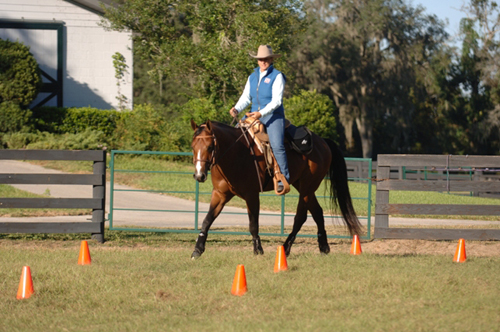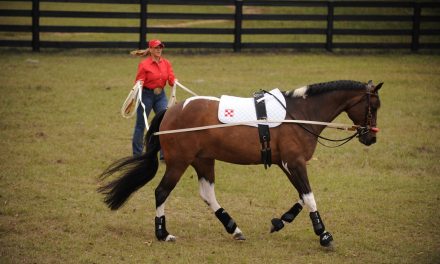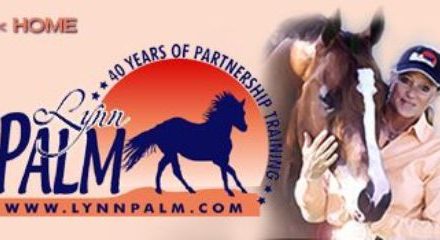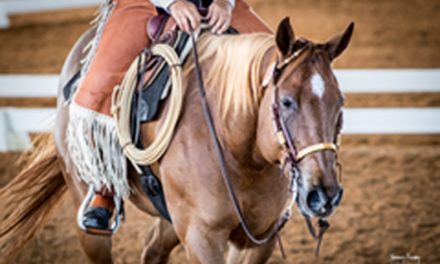BUILDING A PARTNERSHIP WITH YOUR HORSE
 The goal for both the bending and turning aids is to control the horse’s body position and his balance. In this article, I will use a circle pattern to demonstrate how to correct the two most common problems that occur when trying to keep a horse straight through a turn—the problems called falling out and falling in. Many horses have a natural tendency to fall out or fall in when turning. It may be more of an issue when turning in one direction and not so evident when turning in the other direction. It is the rider’s responsibility to anticipate this and know how to correct it using the turning aids.
The goal for both the bending and turning aids is to control the horse’s body position and his balance. In this article, I will use a circle pattern to demonstrate how to correct the two most common problems that occur when trying to keep a horse straight through a turn—the problems called falling out and falling in. Many horses have a natural tendency to fall out or fall in when turning. It may be more of an issue when turning in one direction and not so evident when turning in the other direction. It is the rider’s responsibility to anticipate this and know how to correct it using the turning aids.
Correcting Falling Out
Start at the walk and prepare to bring the horse onto a large circle to the right. Always keep in mind this “golden rule” of riding—to turn correctly, the rider must get the horse bending correctly first. Before the turn, bend the horse using the bending aids (the inside leg and open inside rein) while supporting the bend with the outside leg slightly further back on the horse’s barrel than the inside leg. Also support the bend by using an indirect rein against the neck to position the horse. Use the turning aids, the outside leg and outside indirect rein, to direct him through the turn and then follow the circle.
If the horse travels too far off the curve and drifts to the outside (in this example to the right) as he is turning, he is falling out. He has lost the proper bend in his body. His head has gone too far to the right while his shoulders and hindquarters have left the arc of the circle to the outside (to the left). To correct this, use the left leg to bring the body and hips back to the circle. Use the left rein to bring his shoulders back to the right and onto the circle and to straighten his head and neck from being too far to the right. You still have to support the horse bending right with the right leg and open right rein. Maintain the direction using the bending aids, supporting them by actively using the turning aids.
Change directions through the middle of the circle, and do this exercise to the left. Use the bending aids (the inside leg and open inside rein), and support the bend with the outside leg and outside indirect rein against the neck. Use the turning aids to ask for the change in direction at the same time properly bending the horse to follow the arc of the turn. If the horse falls out in this direction, use the right leg and right rein to correct the problem. To maintain the balance of the horse going to the left, keep the bending aids active (left leg and left rein), and more actively use the turning aids (the right leg and right indirect rein).
Once you have practiced controlling falling out on the circle at the walk, do the exercise at the trot. The bending and turning aids will be applied in the same manner as at the walk. Keep the horse forward at the trot with the inside leg, and use it as the primary bending aid. The inside rein flexes the head inward while the outside leg and rein are the primary aids to keep the horse turning. If he falls out in either direction, use the outside leg and direct outside rein to bring him back onto the circle’s arc. Maintain the bend of the horse with the inside leg and inside rein.
The key to the success of controlling the horse’s balance from falling out is to recognize where it is happening on the circle. Most commonly, a horse falls out as he is going away from a gate, barn, or his pasture or paddock. The rider needs to anticipate this. It is a natural tendency for every horse because his herd instinct encourages it. If the horse does fall out, remind yourself to turn sooner, before the point where he tends to fall out, when you do the next circle.
Correcting Falling In
Falling in is much like if you were to stumble and almost fall. The horse quickens his steps to catch his balance as you would if you tripped. Falling in may present itself as the horse dropping the inside shoulder in a turn, cutting the corner or squaring the corner, or making a turn smaller as a result of not bending while turning. It is the rider’s responsibility to recognize when the horse is falling in and know how to correct it using the bending aids and to make a wider turn.
I will again use the circle pattern to demonstrate how to correct falling in while bending and turning through a turn. Start at the walk and bring the horse onto a large circle to the right. Remember that to turn correctly the rider must get the horse bending correctly first. Before the turn, bend the horse using the bending aids (the inside leg and open inside rein). At the same time, support the bend with the outside leg applied slightly farther back on the horse’s barrel than the inside leg. Use the outside indirect rein against the neck to support the flexion of the head and curve of the neck and shoulders. Use the turning aids (the outside leg and outside indirect rein) to direct the horse through the turn and then follow the circle.
If the horse is straight, the bend in his body from the poll to the tail (the horse’s spine) will conform to the same arc as that of the circle. The horse being straight while bending means the hind legs track directly into the same track as his front legs. His body alignment stays straight even while bending and turning. His head and neck stay in the middle of the shoulders while curving, and his shoulders stay in line with the hips. The hind legs are directly under the hips, and the front legs are directly under the shoulders. The hind legs track directly in the same track where the front legs take off. This is called being straight while bending.
If a horse travels too far off the curve and drifts to the inside while turning along the arc of a circle, we say he is falling in. He has lost the proper bend in his body. His head and neck are positioned too far to the outside while his shoulders and hindquarters have left the arc of the circle to the inside. The rider will notice quickness or an increase of speed because of the tripping effect. When we lose our balance, our legs quicken to regain it. The same thing happens to the horse. A horse tends to fall in when heading back to the gate or barn.
To correct falling in when on a circle to the right, use the inside leg slightly behind the girth to move the horse out toward to the left to make the circle bigger and bring his barrel and hip back onto the circle. Use the inside (right) rein, now an indirect rein against the neck, to bring his shoulders back to the left and onto the circle. Note: the rein cannot be a stronger aid than the leg because it will bend the neck and bring the head flexed inward too much. This will cause more of the horse’s weight to be placed on his right front leg, which will swing the hips out, leading to another balance problem!
The inside leg, in this example the right leg, is the most prominent correction aid. Move the horse out with the inside leg and inside rein. Support the horse bending right with the inside leg and indirect inside rein to move the shoulders to the left and also to not allow the neck to bend too much. Move the horse out with the inside rein and leg. The rider may also have to sue an open left rein to encourage the horse to go wide to the left while not allowing the neck to bend too much. The outside (left) leg reminds the horse to stay forward in the gait.
The turning aids, the outside rein and outside leg, are not as prominent when the horse is falling in. This is because he is already turning too fast. Use the inside aids more, and keep the horse wider on a curve so he does not turn so fast. When the rider can get the horse going wider while curving, the turning aids can be very minimal to get him to turn.
Make sure you perfect this exercise at the walk, and then move on to the trot and then the canter. If you have trouble with your aids coordination or your hands continue to take charge, go back to the slower gait and continue to work at this. Always repeat the exercise on the horse’s stiffer side at least one more time than on his better side. Repeat the direction and double the number of repetitions on the rider’s weaker side as well. By doubling up practice in the weaker direction of the horse and rider, both will have a greater opportunity to improve.
About the Author
Lynn Palm teaches and coaches riders and horses. She also develops training and educational products. Learn more on Lynn’s Web site at www.lynnpalm.com or call us at 800-503-2824.





